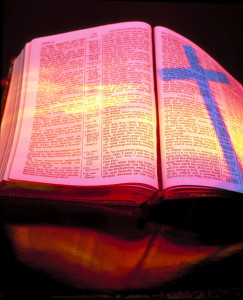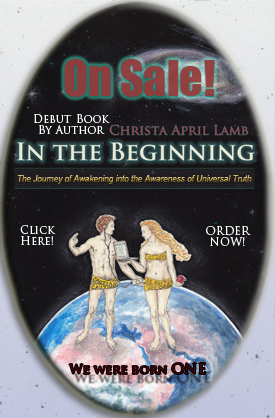Christianity

The Bible is considered the written Word of God for most Christians
| Quick Facts | | History | | Holy Dates | | Denominations | | Connection to other Religions | | Beyond Facts |
QUICK FACTS
Brief explanation:
Christianity is one of the world’s top major monotheistic religions. Christians believe in the teachings of Jesus Christ. In a traditional religious sense, they believe Jesus is the son of God, who was sent to earth to save humankind from itself. As God’s son, Jesus is divine, but he was also a human being who lived with us on earth over 2,000 years ago. Followers of Jesus believe that Christ died on the cross for our sins. They also believe he was born through Immaculate Conception and rose from the dead. Christians share their heritage with the Jewish people. The Jewish Torah and the Old Testament are essentially one and the same.
Christians believe:
o There is only one God
o They believe in the Trinity: The Father, Son and Holy Ghost. These three make up One God
o Jesus is the Son of God, who came to earth, was crucified, but rose again to forgive the sins of the world.
o Baptism of water.
o There is a Heaven and Hell
o Sins can be forgiven
Followers:
There are an estimated 2.1 Billion Christians in the world.
Christians worship by:
o Going to church, especially on Sunday
o Bible reading
o Saying prayers and singing hymns
o Taking communion and the Eucharist
o Participating in the offering or collection
HISTORY
History gathered, collected and provided by the owner of Religion Facts.com
Our sincere thanks for their permission.
Christian history begins with Jesus of Nazareth, a Jew who was born in a small corner of the Roman Empire. Little is known of his early life, but around the age of 30, Jesus was baptized by John the Baptist and had a vision in which he received the blessing of God. After this event, he began a ministry of teaching, healing, and miracle-working. He spoke of the “kingdom of God,” condemned religious hypocrites and interpreted the Mosaic law in new ways. He spoke before crowds of people, but also chose 12 disciples whom he taught privately. They eagerly followed him, believing him to be the long-awaited Messiah who would usher in the kingdom of God on earth.
After just a few years, however, opposition mounted against Jesus, and he was ultimately executed by crucifixion by the Romans. Most of Jesus’ followers scattered, dismayed at such an unexpected outcome. But three days later, women who went to anoint his body reported that the tomb was empty and an angel told them Jesus had risen from the dead. The disciples were initially skeptical, but later came to believe. They reported that Jesus appeared to them on several occasions and then ascended into heaven before their eyes.
The remainder of the first century AD saw the number of Jesus’ followers, who were soon called “Christians,” grow rapidly. Instrumental in the spread of Christianity was a man named Paul, a zealous Jew who had persecuted Christians, then converted to the faith after experiencing a vision of the risen Jesus. Taking advantage of the extensive system of Roman roads and the time of peace, Paul went on numerous missionary journeys throughout the Roman Empire. He started churches, then wrote letters back to them to offer further counsel and encouragement. Many of these letters would become part of the Christian scriptures, the “New Testament.”
In the second and third centuries AD, Christians struggled with persecution from outside the church and doctrinal debates from within the church. Christian leaders, who are now called the “church fathers,” wrote defenses of the false claims made against Christians (apologetics) as well as arguments against false teachings spreading within the church (polemics). Doctrines were explored, developed, and solidified, the canon of the New Testament was formed, and the notion of “apostolic succession” established a system of authority to guard against wrong interpretations of Christian teachings.
A major turning point in Christian history came in the early 4th century AD, when the Roman emperor Constantineconverted to Christianity. The Christian religion became legal, persecution ceased, and thousands of pagans now found it convenient to convert to the emperor’s faith. Allied with the Roman Empire, Christianity gradually rose in power and hierarchy until it became the “Christendom” that would encompass the entire western world in the Middle Ages and Renaissance.
Emperor Constantine hoped Christianity would be the uniting force of his empire, so he was distressed to hear of a dispute over Arianism, which held that Christ was more than a man but less than God himself. In 325 AD, Constantine called the Council of Nicea so that the bishops could work out their differences. They condemned Arius and Arianism and declared the Son (Christ) to be of “one substance” with the Father. After the council, St. Athanasius of Alexandria continued to battle the Arians, but the orthodox view eventually won out for good. The church then turned to issues about Christ’s divine and human natures, which were essentially resolved at the Council of Chalcedon (451 AD).
In the meantime, the considerable religious, cultural, and political differences between the Eastern and Western churches were becoming increasingly apparent. Religiously, the two parts of Christendom had different views on topics such as the use of icons, the nature of the Holy Spirit, and the date on which Easter should be celebrated. Culturally, the Greek East has always tended to be more philosophical and abstract in its thinking, while the Latin West tended toward a more pragmatic and legal-minded approach. As the old saying goes: “the Greeks built metaphysical systems; the Romans built roads.” The political aspects of the split began with the Emperor Constantine, who moved the capital of the Roman Empire from Rome to Constantinople (in modern Turkey). Upon his death, the empire was divided between his two sons, one of whom ruled the western half of the empire from Rome while the other ruled the eastern region from Constantinople.
These various factors finally came to a head in 1054 AD, when Pope Leo IX excommunicated the patriarch of Constantinople, the leader of the Eastern church. The Patriarch condemned the Pope in return, and the Christian church has been officially divided into West (“Roman Catholic”) and East (“Greek Orthodox”) ever since.
In the 1400s, some western Christians began to publicly challenge aspects of the church. They spoke against the abuse of authority and corruption in Christian leadership. They called for a return to the gospel and a stripping off of traditions and customs like purgatory, the cult of the saints and relics, and the withholding of the communion wine from non-clergy. They began to translate the Bible – then available only in Latin – into the common languages of the people.
However, these early reformers did not have widespread success, and most were executed for their teachings. Legend has it that when Jan Hus, a Czech reformer whose surname means “goose,” was burned at the stake in 1415, he called out: “Today you roast a goose, but in 100 years, a swan will sing!”
In 1517, a German monk named Martin Luther (who bore little resemblance to a swan) posted 97 complaints against the practice of selling indulgences on a church door. He had experienced a personal conversion to the doctrine of justification by faith alone, and also shared many of the ideas of those early reformers. Growing German nationalism and the invention of the printing press ensured that Luther would have greater protection than his predecessors and his teachings would be spread quickly. He was excommunicated and barely escaped with his life on more than one occasion, but Luther lived out his life spreading the Reformation, and died a natural death. His ideas had already spread throughout Germany, and similar reforming movements sprung up in England and Switzerland. Soon much of Europe was embroiled in a civil war, with Protestant nationalists fighting Catholic imperialists for religious and political freedom.
In the 17th century, Christians of many ideologies embarked on the hazardous journey across the Atlantic, to the promise of religious freedom and economic prosperity in the New World. Quakers came to Pennsylvania, Catholics to Maryland, and Dutch Reformed to New York. Later came Swedish Lutherans and French Huguenots, English Baptists and Scottish Presbyterians. With the exception of some Puritan communities, there was no attempt to impose religious uniformity in America.
The period from about 1648 to 1800 was an age in which reason (as opposed to revelation and dogma) became increasingly important, but so did religious revival. Benjamin Franklin exemplified his time’s general attitude towards religious matters when he remarked, a few weeks before his death:
As to Jesus of Nazareth…I have…some doubts as to his Divinity, tho’ it is a question I do not dogmatize upon, having never studied it…. I see no harm, however, it its being believed, if that belief has the good consequence…of making his doctrines more respected and better observed.
At the same time that religious skepticism and toleration were growing in the west, so too were revival movements that sought to return to masses to genuine faith in Christ and the gospel of salvation. George Whitefield arrived in the colonies from England in 1739, and experienced wide success with his revival sermons. Jonathan Edwards was famous for his fiery sermons in which he described in detail the torments of those who do not have personal faith in Jesus Christ. John Wesley was revivalist preacher and a personal friend of Whitefield, but he differed strongly from his Presbyterian friend on the doctrine of predestination. Wesley founded a small group of preachers and bible students, who focused on holy living and came to be called the “Methodists.”
Today, Christianity is the largest world religion, with about 2 billion adherents. It is the majority religion of Europe and the Americas, and there are churches in almost every nation in the world. There are perhaps thousands of Christian denominations, all of whom believe in the basic doctrines established at the Council of Nicea but differ in other matters of doctrine and practice. In recent years, there has been a growing movement among these denominations to work together in unity for the good of the world. In 1948, the World Council of Churches was founded to that end.
HOLY DATES
Important Holy dates, Holidays, or Seasons:
o Lent: Begins Starts 40 days before Easter to prepare for Easter.
o Palm Sunday: Sunday before Easter is observed as the day Christ entered into Jerusalem.
o Maundy Thursday: Thursday before Easter represents the Last Supper.
o Good Friday: Friday before Easter is observed Christ’s crucifixion on the cross.
o Easter: First Sunday after the first full moon after March 21 is celebrated as the day Christ was resurrected.
o Ascension Day: 40 days after Easter on a Thursday, Christians celebrate the ascension of Christ
o Pentecost: 50 days after Easter celebrated as the decent of the Holy Spirit on Christ’s followers.
o Advent: 4 Sundays before Christmas, Christians prepare for Christmas.
o Christmas: December 25th is the day dedicated to the birth of Christ.
DENOMINATIONS
Major Denominations and their adherents:
Catholicism – (1,200,000,000 adherents)
Roman Catholic Church (1,131,000,000)
Protestantism – (699,000,000 adherents)
Pentecostalism (129,000,000)
o Assemblies of God (54,700,000)
o New Apostolic Church (11,000,000)
o Foursquare Church (8,000,000)
o Church of God in Christ (5,490,000)
Baptist (105,000,000)
o Southern Baptist Convention (16,300,000)
o American Baptist (1,396,700)*
Lutheranism (87,000,000) Click for beliefs.
o Evangelical Lutheran Church in America (4,800,000)
Methodism (75,000,000)
o United Methodist Church (12,000,000)
o African Methodist Episcopal Church (5,000,000)
Reformed Churches (75,000,000)
o Presbyterian Church U.S.A. (3,000,000)
o United Church of Christ (1,200,000)
Non-Denominational Evangelicalism (40,000,000)
o Calvary Chapel (25,000,000)
o The Vineyard (15,000,000)
Restorationism (20,000,000)
o Seventh-day Adventists (15,000,000)
o Church of Christ (5,000,000)
o Christian Church (Disciples of Christ) (750,000)
Anabaptism (4,500,000)
o Mennonites (1,300,000)
o Amish (200,000)
Eastern Orthodoxy – (260,000,000 adherents)
Oriental Orthodox Church – (81,000,000 adherents)
Anglicanism – (77,000,000 adherents)
Episcopal Church in the U.S.A. (2,150,000)
Nontrinitarianism – (36,000,000 adherents)
Jehovah’s Witnesses (17,670,000)
Mormonism (13,400,000)
Nestorianism – (1,000,000 adherents)
Source:
http://churchrelevance.com/qa-list-of-all-christian-denominations-and-their-beliefs/ http://www.ncccusa.org/news/070305yearbook2007.html
CONNECTION TO OTHER RELIGIONS
Links to some great pages comparing Christianity to other religions:
Religion Fact Comparison Chart:
Christianity compared to Judaism
Christianity compasred to Islam
Christianity compared to Mormonism
Christianity compared to Jehovah Witnesses
Wikipedia:
Christianity compared to Hinduism
Christianity compared to other religions
BEYOND FACTS









